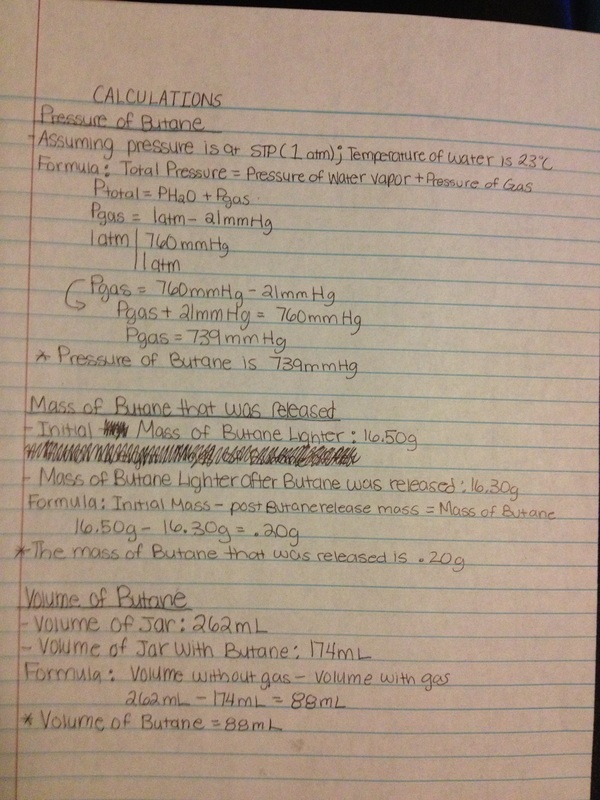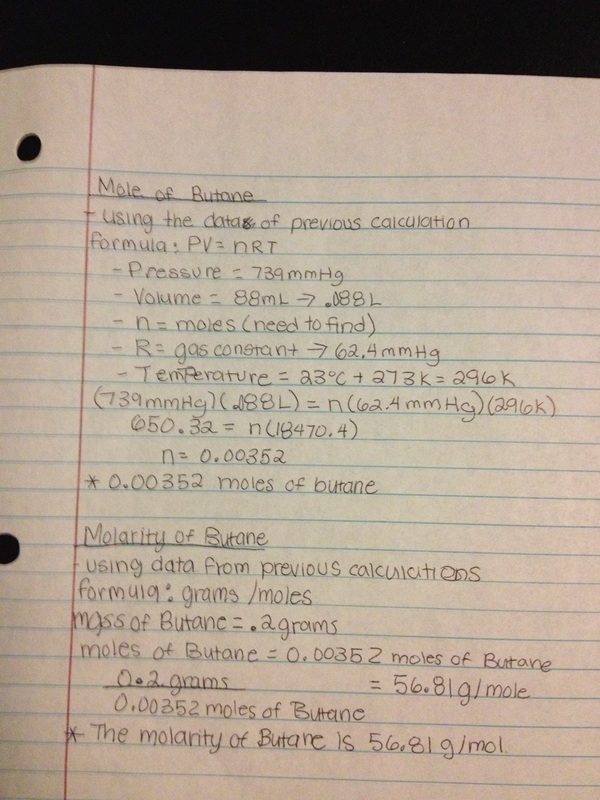
1) The lab starts with the measurement of an empty jar using a calibrated balance.
2) The volume of the jar was measured by filling the jar with water until full. The water is then carefully poured into a graduated cylinder to record how much water (in milliliters) was in the jar
3) The mass of a lighter was measured (in grams) using a calibrated balance.
4) A large plastic bin was filled with enough water to submerge the jar fully underwater.
5) The temperature of the water is measured (in Celsius) using a thermometer.
6) Assuming that the atmospheric pressure is at standard temperature and pressure (STP), the pressure of the butane was calculated by subtracting the pressure of water vapor (found using the chart given) from the standard pressure (1 atm = 760mmHg).
7) The jar was submerged underwater.
8) The air bubbles were carefully extracted from the submerged jar by using a flexible, plastic pipette.
9) After all of the air bubbles were extracted, the lighter was submerged underwater and the butane was released into the jar until the jar is 1/3 full.
10) The jar was taken out of the bin and the lighter let to dry.
11) After the lighter dried off, the mass of the lighter is measured (in grams) using a calibrated balance.
12) The mass of the butane released (in grams) was calculated by subtracting the the weight of the lighter after the butane was released from the initial mass of the butane.
13) The volume of the jar was found by carefully pouring out the water into a graduated cylinder.
14) The volume of the gas if found by subtracting the volume of the jar with the butane from the volume of the jar without the butane.
15) Using the ideal gas law (PV = nRT), the mole was calculated. P represented the pressure which can be found in step 6. V represented the volume of the butane in liters which can be found in step 14. R represented the constant gas. T represented the temperature of the butane (the temperature of the butane was assumed to be equivalent to the temperature of the water) in kelvin which can be found by adding the measurement in step 5 by 273.
16) The molar mass of the butane can be found by dividing the mass of the butane (found in step 12) by the result in step 15.
Mass of the Jar -214.30 gramsVolume of the Jar - 262 mL
Mass of the lighter before releasing the butane - 16.50 grams
Temperature of water- 23°C
Pressure of butane- 739 mmHg
Mass of lighter after releasing the butane - 16.30 grams
Mass of Butane released - 0.20 grams
Volume of jar of water with butane gas - 174 mL
Volume of butane gas - 88mL
Mole of butane - 0.00352 mole of butane
Molar mass of butane - 56.81 grams/mole


The goal of this lab is to find the molar mass of the gas butane (C4H10) in a lighter. Before the lab, the class was instructed to assume that the atmospheric pressure in the room is standard pressure and that the temperature of the butane is equivalent to the temperature of the water in which the lighter was submerged in. After all of the experimentation was done, the data above was provided. To find the molarity of the butane in the lighter, the first step is to find the moles of butane in this experiment and the mass of it. After all of the experimentation was done, the mass of butane was concluded to be 0.20 grams. To find the moles, it was essential to utilize the ideal gas law (PV = nRT). Using the data provided through the procedures, the numerical value of the pressure, volume, gas constant, and temperature was substituted into the equation. Using algebra, the moles was founded to be 0.00352 moles of butane. In order to find the molarity, the mass of the butane should be divided by the moles. After further calculations, the molarity of the butane gas was calculated to be 56.81 grams/moles. This lab is done with tons of sources of error. They include wrongly read measurement, poor calibration of the balance, air bubbles released too early, air bubbles remaining in the jar, the unknown true temperature of the butane, miscalculations, and the misreading of measurements.
1) Based on calculations, the molar mass of the gas was calculated to be 56.81 grams/moles
2)Because the gas is an alkane, it contains only carbon and hydrogen with single bonds. Based on the the molar mass of the gas produced in this lab, a possible formula for the gas could be C4H9. The reason for this formula is because in this lab, the molar mass calculated was 56.81 grams per mole. To make is more simple, the molar mass was rounded to 57 grams per mole. The molar mass of carbon is approximately 12.01 grams per mole. The molar mass of hydrogen is approximately 1.008 grams per mole. To begin this assumption, the moles of carbon should be found first. To find the moles, the molar mass of the gas (57 g/m) should be divide by the molar mass of carbon (12 g/m). This would result in around 4.75 moles of carbon. Because the subscript in a formula cannot have decimals, the moles of the carbon in this formula is 4. To find the moles of hydrogen, the remaining, the difference of the mass of the gas and the molar mass of carbon should be found (approximately 9 g/m). Divide 9 by the molar mass of hydrogen (1 g/m) and that gives the mole for hydrogen.
3) Most of the gas in the lighter is butane. The chemical formula for butane is C4H10. The molar mass of butane is 58 g/m
Formula: (Accepted value - Result)/accepted value x 100 = Percent of error
[((58 g/m) - (56.81 g/m)) / (58 g/m)] x 100 = 2.0%
The percent of error is 2.0%
4a) If I were to forget to change Celsius temperature to Kelvin, the molar mass of the gas would have been lower. When using the ideal gas law, it is essential to convert the Celsius to Kelvin. When calculating the moles, if the Celsius is not converted, the moles would have significantly larger. The product of the pressure and the volume would be divided by a smaller number, resulting in a larger mole. When calculating for the molar mass, the mass of the gas would be divided by a larger number, resulting in a lower molar mass
Error: (739mmHg)(.088L) = n(62.4 mmHg)(23°C) --> moles = 0.04531 molar mass = 0.20 grams / .04531 --> molar mass = 4.41 < 56.81
4b) If I forgot to include the pressure of water vapor, the molar mass of the gas would have been lower. There would be no need to use Dalton’s Law of Partial Pressures due to the fact that the pressure of the gas is the total pressure. The pressure of the gas would be higher. When calculating the moles, if the pressure of water vapor is not corrected, when using the ideal gas law, the product of the pressure and volume would be significantly larger. This would make the moles larger. When calculating for the molar mass, the mass of the gas would be divided by a larger number, resulting in a lower molar mass.
4c) If I forgot to remove the air bubbles in the jar before I released the ligher gas into it, the molar mass of the gas would have been lower. If there were air bubbles in the jar, the volume of the jar with the gas in it would have been greater than the calculated volume. When calculating the moles, if the air bubbles were not removed, when using the ideal gas law, the product of the pressure and volume would be significantly larger. This would make the moles larger. When calculating for the molar mass, the mass of the gas would be divided by a larger number, resulting in a lower molar mass.
4d) If the lighter was not completely dry,the molar mass of the gas would have been lower. If there was still water in the lighter, the water could add to the mass of the lighter when weighing the lighter. When finding the mass of the gas released, the formula used was the initials mass of the lighter minus the mass of the lighter after the gas was released. If there was still water in the lighter, the mass of the gas would be smaller. When finding the molar mass, the mass is divided by the moles. If the mass is smaller and the moles is the same, the molar mass would be smaller.
5) Given that there are several gas mixed together in the lighter fluid, I think that the molar mass of the other gases is lower than the molar mass of the butane. The molar mass of our gas was 56.81 g/m which was only a 2% error in comparison to the actual molar mass. Because the molar mass of the gas was less than the actual molar mass, it can be assumed that the calculation is pretty accurate and that the molar mass of the butane is larger than the other gases.
6) The substance inside the lighter is a liquid because the gas is under enormously high pressure. This results into a phase change from a gas into a liquid. When the trigger is pressed to release the gas, the pressure is released, causing an immediate phase change from liquid to gas.